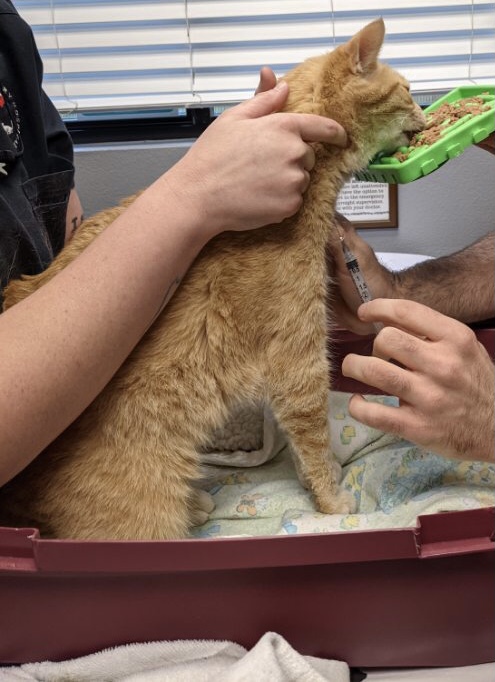How to Draw Blood From a Kitten
Reading Time: 3 minutes
Once you've trained your cat to accept restraint, you can start training for blood draws. Depending on your cat's age and lifestyle, they may need regular blood draws for wellness or to test for diseases such as FeLV/FIV. Of course, you won't actually be poking them with needles at home, but by teaching them to accept the handling used by veterinary staff to draw blood, you can help reduce their fear, anxiety, and stress.
Common blood draw locations for cats are their jugular veins, which run on either side of the windpipe. For jugular restraint, seat your cat on a non-slip bed on the counter and stand behind them. Let their lower jaw rest on your middle fingers while you put your pointer fingers on their temples and your thumbs behind their ears, then treat and release. Gradually train your cat to accept a 30-second head hold.

Next, train from the perspective of the person drawing blood. While facing your cat, move your thumb apart from the other fingers to make a Y. Gently press your hand against your cat's throat just above the collarbone, then treat and release. After they're used to the pressure, apply the Y, rub back and forth on one side of the neck with your opposite fingers, then treat and let go.
Another common blood draw site is the cephalic vein, which runs on top of the forearm. Standing next to your cat, hug their head from underneath with your left hand while your right hand picks up their right leg under the elbow, then treat. Gradually get them used to having their right leg gently pushed forward a few inches. Next, try "rolling" the vein with your thumb from the inside of the leg towards the outside by moving the skin just below the elbow. Practice using treats until your cat is used to restraint and having their leg held/rolled for 30 seconds, then repeat with the other leg.
You should also teach your cat to accept cephalic handling by working from their front. While facing your cat, briefly cup their foreleg with one hand, then treat. Slowly increase the time their leg is held until you've reached 30 seconds. Using your other hand, rub the top of their stabilized forearm and treat. Most cats don't like having their legs held, so watch for signs of stress, and keep sessions short and positive.
The last common site for feline blood draws is their medial saphenous vein, which runs on their inner thigh. First, your cat will need to be comfortable lying down on their chest while their hind legs are stacked and facing to one side. With your cat lying down, practice hugging their chest from behind with one arm. Using your opposite fingers, briefly hold the top hind leg at the hock, then treat and release. Next, get your cat used to having their leg held and flexed at the knee while your hand rests on their abdomen. Finally, while their leg is flexed, practice placing pressure on the inner thigh of the bottom leg using your pinky. Build up to 30 seconds, treating before releasing the leg each time. To train for drawing blood, face your cat's abdomen while they are lying down in the position described above. Gently hold their bottom leg below the knee, then treat and let go. Using the fingers of your other hand, rub their inner thigh while their leg is held, and treat and release.
For all types of blood draws, the vet staff will usually apply alcohol to their vein to make it stand up. Having their skin suddenly wetted down can be scary, so do additional training with a little squeeze bottle of water. You can also use a ballpoint pen to gently touch their neck or their leg to simulate a needle poke. If you have a partner to help with training, one person can practice restraint while the other pretends to draw blood. As with vaccines, needle pokes can be painful, so ask your vet for a recommended topical lidocaine cream that can be applied to areas of blood draw several hours before their visit to help make their experience even more Fear Free.
This article was reviewed/edited by board-certified veterinary behaviorist Dr. Kenneth Martin and/or veterinary technician specialist in behavior Debbie Martin, LVT.
Julie Liu, DVM, CVA (Certified Veterinary Acupuncturist) is a small-animal veterinarian who practices in Austin, Texas. In addition to advocating for Fear Free handling of pets, she is passionate about feline medicine and senior pet care.
Published May 17, 2021
How to Draw Blood From a Kitten
Source: https://www.fearfreehappyhomes.com/blood-draws-cats/
Post a Comment for "How to Draw Blood From a Kitten"